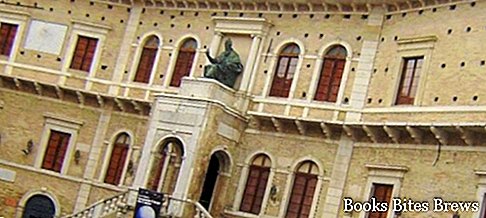What to see in Fermo, itinerary including the main monuments and places of interest, including Piazza del Popolo, Roman Cisterns, Palazzo dei Priori, Loggiato di San Rocco and Assunta Cathedral.
Tourist information
Town of the Marche perched on Colle Sàbulo, also called Girifalco, Fermo rises 319 meters above sea level and about 8 km from the Adriatic Sea, where the renowned beaches of Lido di Fermo, Casabianca and Marina Palmense are located.
In the hinterland, a gentle hilly landscape extends to the Sibillini Mountains.
Fermo was a large Piceno-Villanovan center, before becoming the important Roman colony of Firmum Picenum.
With the end of the Western Roman Empire, the city was subject to barbarian invasions, which was followed by annexation to the Lombard and Frankish kingdoms, which was subsequently subjected to papal rule.
It became the center of the Marca Fermana, an ancient administrative subdivision of central Italy, and at the end of the twelfth century it became a free municipality.
It was ruled by various lordships, until the mid-fifteenth century, when it returned to the Church.
In the Napoleonic period it was part of the first Kingdom of Italy.
Of ancient Roman and medieval order, Fermo preserves a Renaissance urban layout rich in remarkable architecture and artistic beauty, starting from Piazza del Popolo, dominated by the sixteenth-century Palazzo dei Priori whose facade opens like a fan over the elegant open space flanked by arcades.
In the Palazzo dei Priori there is the Municipal Art Gallery, with prestigious works including the Adoration of the Shepherds by Pieter Paul Rubens, the Mycenae section of the Archaeological Museum, where interesting finds from the pre-Roman city are preserved, the Town Halls and the seventeenth-century Sala del Mappamondo, the oldest public library in the Marche region, characterized by a large globe dating back to the eighteenth century.
In addition, on the same square it is possible to admire the loggia of San Rocco and the Apostolic Palace, built at the beginning of the sixteenth century to house the papal legates.
Recommended readings- Fossombrone (Marche): what to see
- Marche: Sunday day trips
- Fermo (Marche): what to see
- Marche: what to see among valleys, hills and ancient villages
- Osimo (Marche): what to see
What see
Near the Piazza del Popolo, on the top of the hill, where the acropolis of the ancient Roman center stood, stands the Cathedral dedicated to the Assumption, whose construction dating back to 1227 remains the front with the imposing Romanesque-Gothic facade, the atrium decorated with fourteenth-century frescoes and the bell tower, the rest is the result of the eighteenth-century reconstruction by Cosimo Morelli.
Inside, some works of sculpture are of great interest, including the fourteenth-century sepulcher of Visconti, a Byzantine icon, the remains of the early Christian mosaic floor and an early Christian sarcophagus, dating back to the third-fourth century and located in the thirteenth-century crypt.
In the basement of the church, remains of early Christian and early medieval buildings have been found.
Noteworthy is the wonderful Teatro dell’Aquila, built on a project by the architect Cosimo Morelli starting from 1780, which constitutes one of the major achievements of this type in the Marche region.
The backdrops of the scenographer Alessandro Sanquirico, the ceiling and the curtain of the Roman painter Luigi Cochetti are very interesting.
In the basement of the city are the Roman Cisterns, an architectural complex consisting of 30 communicating rooms, used for the collection and distribution of water to the city, built in the first century AD.
In the Church of San Francesco, whose construction began in 1240 and ended in the first part of the fifteenth century, inside the apse chapel, there are remarkable remains of frescoes painted by Giuliano da Rimini, one of Giotto's most important pupils.
The co-cathedral church of San Domenico, dating back to 1223 and reworked between the eighteenth and nineteenth centuries, houses a remarkable wooden choir dating back to 1448.
In the Church of Sant'Agostino, built in the thirteenth century and restored in 1738, there are frescoes from eras between the thirteenth and fifteenth centuries.
Attached to the Church is the Oratory of Santa Monica, which preserves an extraordinary cycle of late Gothic frescoes inside.




